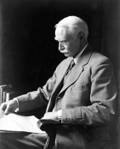W. D. Caröe
William Douglas Caröe | |
|---|---|
 W. D. Caröe | |
| Born | 1 September 1857 Holmsdale, Blundellsands near Liverpool, |
| Died | 25 February 1938 (aged 80) Kyrenia, Cyprus |
| Nationality | British |
| Occupation | Architect |
William Douglas Caröe (1857–1938) was a British architect, particularly of churches.
Early life[]
Caröe was born on 1 September 1857 in Holmsdale, Blundellsands near Liverpool, the youngest son of the Danish Consul in Liverpool, Anders Kruuse Caröe (d. 1897) and Jane Kirkpatrick Green (d. 1877). He was educated at Ruabon Grammar School in Denbighshire, Wales before Trinity College, Cambridge, as a senior optime, in the mathematical tripos of 1879[1] and graduated with a BA in the same year.[2] Caröe was articled to John Loughborough Pearson[3] and wrote the article on Pearson in the Encyclopædia Britannica, (11th ed., 1911).
He married Grace Desborough (d.1947), with whom he had two sons and a daughter. The couple's elder son was (Sir) Olaf Kirkpatric Kruuse Caröe (1892–1981), who became an Indian administrator; then came a daughter, Christian Desborough Caröe (1894–1973); and finally a second son, Alban Douglas Rendall Caröe (1904–1991), who followed his father’s footsteps in architecture.
Biography[]

William Douglas Caröe was a major figure in the Arts and Crafts Movement and described as a “Master of spatial painting”.[4] The firm he founded, Caroe & Partners, still specialises in ecclesiastical architecture, especially the restoration of historic churches.[5]
Caröe was architect to numerous ecclesiastical buildings including St David's and Durham Cathedrals, and Tewkesbury and Romsey Abbeys.[5] Although Caröe primarily made his name in church architecture, he was also the architect for the Main Building of Cardiff University, inspired by his alma mater Trinity College.[6]
Caröe designed additions to his country house, Vann in Hambledon, Surrey.[7] The house was featured in the TV series The Curious House Guest in 2006.
No. 1 Millbank, London, was built for the Church Commissioners in 1903.[8]
See also[]
- Category:Buildings by W. D. Caröe
Gallery[]

St David's Church, Exeter (1897–1900)

Cardiff University main building

The Church of St Sabinus in Woolacombe in Devon (1912)

Stoke-by-Nayland War Memorial in Suffolk (1921)
References[]
- ^ MacAlister, Ian (2005). "William Douglas Caröe". Oxford Dictionary of National Biography. Oxford University Press. Retrieved 16 September 2016.
- ^ "Caröe, William [Douglas] (CRW875WD)". A Cambridge Alumni Database. University of Cambridge.
- ^ "Caröe, William Douglas". Who's Who. Vol. 59. 1907. p. 296.
- ^ "Charismatic Caroe". RIBA. 98 (2). 1992.
- ^ Jump up to: a b "About Caroe and Partners architects – history of WD Caroe – Stainburn Taylor". caroe.co.uk. Retrieved 14 September 2016.
- ^ "Main Building Centenary Profile: Grand Designs". Cardiff University. Retrieved 28 October 2014.
- ^ "History". Vann. Retrieved 3 May 2017.
- ^ Historic England. "THE CHURCH COMMISSIONERS, City of Westminster (1267603)". National Heritage List for England. Retrieved 3 October 2017.
Bibliography[]
- Jennifer M. Freeman (1991) W. D. Caroe: His Architectural Achievement ISBN 0-7190-2449-8
| Wikimedia Commons has media related to William Douglas Caroe. |
External links[]
| Wikisource has original works written by or about: William Douglas Caroe |
- Caroe & Partners
- Entry in the Oxford Dictionary of National Biography
- 1857 births
- 1938 deaths
- People educated at Ruabon Grammar School
- Alumni of Trinity College, Cambridge
- Members of the Cambrian Archaeological Association
- British ecclesiastical architects
- People from Crosby, Merseyside
- British people of Danish descent
- Architects from Lancashire



